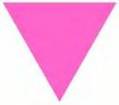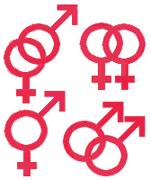 | |
Gay
Symbols
|

|
THE RAINBOW FLAG
The rainbow flag has become the most easily-recognized colours of
gay pride. The multicultural symbolism of the rainbow is nothing new --
Jesse Jackson's Rainbow Coalition also embraces the rainbow as a symbol of
that political movement, as did Nelson Mandela in his concept of the
Rainbow Nation. The rainbow also plays a part in many myths and stories
related to gender and sexuality issues in Greek, Native American, African,
and other cult-ures.
Use of the rainbow flag by the gay community began in 1978 when it
first appeared in the San Francisco Gay and Lesbian Freedom Day Parade.
Borrowing symbolism from the hippie movement and black civil rights
groups, San Francisco artist Gilbert Baker designed the rainbow flag in
response to a need for a symbol that could be used year after year. Baker
and thirty volunteers hand-stitched and hand-dyed two huge prototype flags
for the parade. The flags had eight stripes, each colour
representing a com-ponent of the community: hot pink for sex, red
for life, orange for healing, yellow for sun, green for nature, turquoise
for art, indigo for harmony, and violet for spirit.
The next year Baker approached San Francisco Paramount Flag Company
to mass-produce rainbow flags for the 1979 parade. Due to production con-straints
-- such as the fact that hot pink was not a commercially-available color
-- pink and turquoise were removed from the design, and royal blue
replaced indigo. This six-colour version spread from San Francisco to
other cities, and soon became the widely-known symbol of gay pride and
diversity it is today. It is even officially recognized by the
International Congress of Flag Makers. In 1994, a huge 30-foot-wide by
one-mile-long rainbow flag was carried by 10,000 people in New York's
Stonewall 25 Parade.
The rainbow flag has inspired a wide variety of related symbols, such as
freedom rings and other accessories. There are plenty of variations of the
flag, including versions with a blue field of stars reminiscent of the
American Stars and Stripes and versions with
superimposed lambdas, pink triangles, or other symbols.
|
|

|
THE VICTORY OVER AIDS FLAG
The Victory Over AIDS Flag modifies the rainbow flag by adding a
black stripe at the bottom. Suggested by a San Francisco group, the black
stripe commemorates those we have lost to AIDS. Sergeant Leonard Matlovich,
a much-decorated Vietnam Veteran dying of AIDS, proposed that when a cure
is eventually found the black stripes should be
removed from all the flags and ceremoniously burned in Washington, D.C.
|
|

|
THE PINK TRIANGLE
The pink triangle is easily one of the more popular and widely-recognized
symbols for the gay com-munity. The pink triangle is rooted in World War
II times, and reminds us of the tragedies of that era. Although
homosexuals were only one of the many groups targeted for extermination by
the Nazi regime, it is unfortunately the group that history often
excludes. The pink triangle challenges that notion, and defies anyone to
deny history.
The history of the pink triangle begins before WWII, during Adolf Hitler's
rise to power. Paragraph 175, a clause in German law prohibiting
homosexual relations, was revised by Hitler in 1935 to include kissing,
embracing, and gay fantasies as well as sexual acts. Convicted offenders
-- an estimated 25,000 just from 1937 to 1939 -- were sent to prison
and then later to concentration camps. Their sen-tence was to be
sterilized, and this was most often accomplished by castration. In 1942
Hitler's punish-ment for
homosexuality was extended to death.
Each
prisoner in the concentration camps wore a coloured inverted triangle to
designate their reason for incarceration, and hence the designation also
served to form a sort of social hierarchy among the prisoners. A green
triangle marked its wearer as a regular criminal; a red triangle denoted a
political prisoner. Two yellow triangles overlapping to form a Star of
David designated a Jewish prisoner. The pink triangle was for homosexuals.
A yellow Star of David under a superimposed pink triangle marked the low-est
of all prisoners - a gay Jew.
Stories of the camps depict homosexual prisoners being given the worst
tasks and labours. Pink tri-angle prisoners were also a proportionally
large focus of attacks from the guards and even other inmates. Although
the total number of the homo-sexual prisoners is not known, official Nazi
estimates were an underwhelming 10,000.
Although homosexual prisoners reportedly were not shipped en masse to
the death camps at Auschwitz, a great number of gay men were among the
non-Jews who were killed there. Estimates of the number of gay men killed
during the Nazi regime range from
50,000 to twice that figure. When the war was finally over, countless many
homosexuals remained prisoners in the camps, because Paragraph 175
remained law in West Germany until its repeal in 1969.
In the 1970s, gay liberation groups resurrected the pink triangle as a
popular symbol for the gay rights movement. Not only is the symbol easily
recognized, but it draws attention to oppresion and persecution -- then
and now. In the 1980s, ACT-UP (AIDS Coalition To Unleash Power) began
using the pink triangle for their cause. They inverted the symbol,
making it point up, to signify an active fight back rather than a passive
resignation to fate. Today, for many the pink triangle represents pride,
solidarity, and a promise to never allow another Holocaust to happen
again.
|
|

|
THE RED RIBBON
The AIDS Awareness Ribbon, or red ribbon, is commonly seen adorning
jacket lapels and other articles of clothing as a symbol of solidarity and
a commitment to the fight against AIDS.
The Ribbon Project was conceived in 1991 by Visual AIDS, a New York-based
charity group of art pro-fessionals that aims to recognize and honor
friends and colleagues who have died or are dying of AIDS. Visual AIDS
encourages arts organizations, museums, commercial galleries, and AIDS
support groups to commemorate those lost to AIDS, to
create greater awareness of AIDS/HIV trans-mission, to publicize the needs
of Persons With AIDS, and to call for greater funding of services and
research. Inspired by the yellow ribbons honoring American soldiers of the
Persian Gulf War, the color red was chosen for its connection to blood and
the idea of passion -- not only anger, but love, like a
valentine, as stated by Frank Moore of Visual AIDS.
Worn by host Jeremy Irons, the ribbon made its public debut at the 1991
Tony Awards, and soon became a popular and politically correct fashion
statement for celebrities and other awards cere-monies. Because of this
popularity, some activists worry that the ribbon has become simple lip
service to AIDS causes; in one particular incident the First Lady Barbara
Bush wore a red ribbon while sitting in the audience with her husband, but
when she stood at the President's side during his speech, her ribbon was
conspicuously missing.
However, the Ribbon Project remains a powerful force in spreading
awareness of AIDS and stressing the need for further action and research
of the disease. The sincerest hope for the Ribbon Project is that it will
one day no longer be needed.
Inspired by the red ribbon, the pink ribbon became the symbol for breast
cancer awareness. Although, like AIDS, breast cancer is certainly not an
issue limited to the gay community, the statistics of breast cancer are
historically higher in women who do not
bear children. Consequently, for some lesbians breast cancer awareness and
prevention is a parti-cularly important issue.
Yellow ribbons have historically been used to raise awareness for POW/MIA
persons, hostages, and human rights and equality movements. Additionally,
the politically-correct nature of the times seems to have spawned even
more ribbon variations. Green ribbons are worn by environmental activists,
parti-cularly those in the entertainment industry con-cerned about the use
of tropical plywood in movie sets. Purple ribbons signify the toll of
urban
violence; blue ribbons promote awareness of crime victims' rights. (More
recently, blue ribbons have also been adopted by the campaign against
Internet censorship.) With all these ribbon variations, it is important to
realize that no one cause is trying to take attention away from the
others; in one way or another, all are equally important to humanity.
|
|

|
GENDER PRIDE SYMBOLS
Gender
Symbols are common astrological signs handed down from ancient Roman
times. The pointed Mars symbol represents the male and the Venus symbol
with the cross represents the female. Double interlocking male symbols
have been used by gay men since the 1970s. Double interlocking female
symbols have often been used to denote lesbianism,
but some feminists have instead used the double female symbols to
represent the sisterhood of women. These same feminists would use three
interlocking female symbols to denote lesbianism. Also, some lesbian
feminists of the 1970's used three interlocking female symbols to
represent their rejection of male standards of monogamy.
Also in the 1970s, gay liberation movements used the male and female
symbols superimposed to represent the common goals of lesbians and gay
men. These days, the superimposed symbols might also denote a heterosexual
aware of the differences and diversity between men and women. A
trans-gendered person might superimpose the male
and female symbols in such a way that the arrow and cross join on the same
single ring.
The astrological sign of Mercury is traditionally the symbol of
transgendered peoples. In Greek mythology, Hermes (the Greek version of
the Roman god Mercury) and Aphrodite (the goddess of love) had a child
named Hermaphroditus. That child possessed both male and female sexual
organs, hence the term hermaphrodite. Also, rituals associated with
the worship of Aphrodite are believed to have been highly sexual,
involving castration, transvestism, and homosexual relations.
In the symbol itself, the crescent moon at the top is supposed to
represent the masculine, and the cross at the bottom represents the
feminine. The ring represents the individual, with the male and the female
balanced at either side.
|
|

|
LAMBDA
The lambda symbol seems to be one of the most controversial of
symbols in regards to its meaning. There are several differing opinions as
to why the lambda was chosen as a gay symbol and what it really means.
However, most sources agree on a few things:
The lambda was first chosen as a gay symbol when it was adopted in 1970 by
the New York Gay Activists Alliance. It became the symbol of their growing
movement of gay liberation. In 1974, the lambda was subsequently adopted
by the International Gay Rights Congress held in Edinburgh, Scotland. As
their symbol for lesbian and gay rights, the lambda became internationally
popular.
But where history ends, speculation begins. No one seems to have a
definitive answer why the lambda was originally chosen as a gay symbol.
Some suggest that it is simply the Greek lower-case letter l for
liberation. Others disagree, citing the use of lambda in physics to denote
energy (the energy we have when we work in concert) or wavelength (are
gays and lesbians on a different wavelength?). Lambda may also denote the
synergy of the gay movement, the idea that the whole is greater than the
sum of its parts. The lambda also may represent scales and balance, and
the constant force that keeps opposing sides from overcoming each other --
the hook at the bottom of the right leg signifies the action needed to
reach and maintain balance. The ancient Greek Spartans regarded the lambda
to mean unity, while the Romans considered it "the light of knowledge
shed into the darkness of ignorance." Reportedly, Ancient Greeks
placed the lambda on shields of Spartan warriors, who were often paired
off with younger men in battle. (There was a theory that
warriors would fight more fiercely knowing that their lovers were both
watching and fighting alongside them.)
Whatever the exact meaning and origin, the lambda originally embodied a
fairly militant connotation. Today, the symbol generally denotes lesbian's
and gay men's concerns together. Although the lambda was never intended to
be linked to any specific gender or orientation such as other symbols may
be, historically this is not so: In the early 1970's the
Los Angeles gay community created a flag with a lavender lambda on a
simple white background. They hoped the flag would catch on to other
cities, but their hopes were not realized because some saw the lambda as a
male symbol only.
|
|






